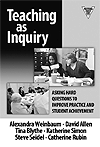 By Alexandra Weinbaum, David Allen, Tina Blythe, Katherine Simon, Steve Seidel and Catherine Rubin (Teachers College Press, 192 pages, $21.95) BUY NOW!
By Alexandra Weinbaum, David Allen, Tina Blythe, Katherine Simon, Steve Seidel and Catherine Rubin (Teachers College Press, 192 pages, $21.95) BUY NOW!
reviewed by Jill Davidson
In the field of education, we believe we can, in time and with effort, better understand the interaction among people that is teaching and learning,” writes Teaching as Inquiry’s chorus of co-authors, who offer a solid foundation in the theory and practice of looking at evidence, particularly student work, through collaborative inquiry. Written as the result of a bona fide collaborative effort—a befitting approach, both as a practice-what-you-preach compliment and as a practical and meaningful way to include multiple perspectives—Teaching as Inquiry emerged from a National Study Group funded by the Wallace Foundation and formed by the Academy of Educational Development, Project Zero, and CES National, whose co-director Kathy Simon participated as an author.
The book opens with two chapters on the theory and practice of collaborative inquiry. The first reviews the research on school-based collaborative inquiry, breaking it down into six types. For professional learning communities seeking to weave inquiry into their work, this background is essential. Just as indispensable is the second chapter’s discussion of defining and communicating the purpose of inquiry, matching subject to method, and determining who should participate. Close attention paid here will likely have a tremendous positive influence on collaborative inquiry efforts.
The four middle chapters represent collaborative inquiry in various forms and stages at four schools. These chapters vividly demonstrate the multi-year process of group examination of teacher and student work in pursuit of better learning and teaching, portraying what it’s like for a group of professionals to think deeply about the work that happens in a school. Each of these chapters were written by school coaches or other such facilitators from the Academy of Educational Development, Project Zero, or the CES network, and a vivid subtext throughout Teaching as Inquiry is the crucial role of consistent “outsiders” who know the school well and can push, listen, support, challenge, guide, and analyze as the situation warrants.
The seventh chapter uses examples from the book’s four case studies to illustrate fairly predictable milestones in a learning community’s inquiry process. The eighth lists key questions that a group willing to devote hours to group inquiry should use as provocations to refine their efforts.
Most likely of greatest value to learning communities committed to a deep, multi-year cycle of inquiry, Teaching as Inquiry provides a synthesis of practical tools and theoretical frameworks to encourage thoughtful improvement of professional practice and student learning.
